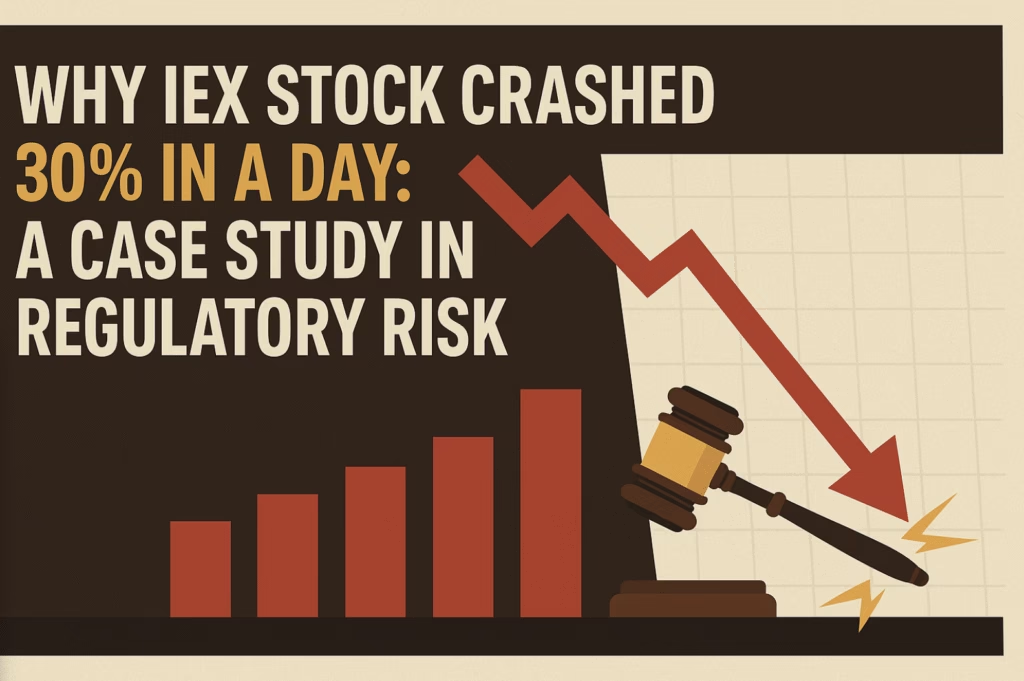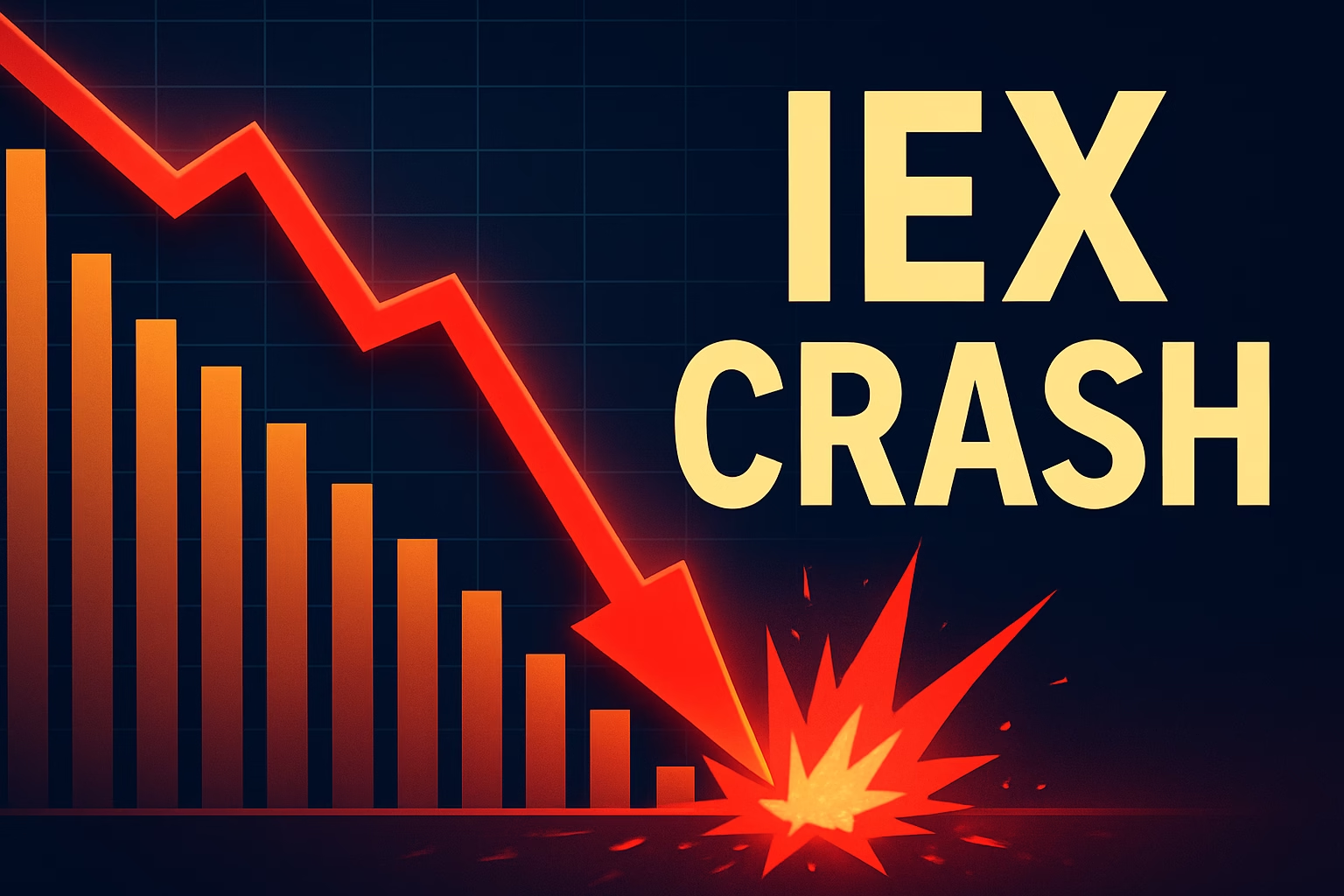30% fall in stock is not an ordinary thing in the stock market. Last week, INDIAN ENERGY EXCHANGE (IEX) company experienced the biggest fall in its stock history….

30% fall in stock is not an ordinary thing in the stock market. Last week, INDIAN ENERGY EXCHANGE (IEX) company experienced the biggest fall in its stock history, leaving many finance students and finance enthusiasts wondering what happened with the business — why the stock fell by 30% in a day. Rs 4600 crore market capitalisation wiped out in a single day — this wasn’t due to poor quarterly results. In fact, the stock has reported 13% revenue increase and net profit has increased by 25% year on year. Instead, the drop in stock is triggered by fundamental changes in its business environment.
Before understanding the fall, we have to understand how the Indian power industry and the business work of IEX.
Understanding about Indian power industry and Indian Energy Exchange business model.
Firstly, we have to understand the Indian power industry. It’s divided into three parts:
Generators: This includes companies like NTPC, ADANI POWER, and ReNew Power which generate electricity from coal, hydro, solar and wind sources. Think of them like the chef this company are chef in generate electricity.
Transmitters: Transmitter companies provide infrastructure to travel electricity from one city to another. Think like the highway of electricity or tomato of electricity. Companies like Power Grid work in this space.
Distributors: companies like MSME, and BSES — these companies connect electricity to households or companies. this companies handle meters, billing, and outages — basically, distributors are the delivery agents for power. These companies create contracts with generators for a time period of 20 or 25 years.
But if your electricity consumption goes down, you still have to pay full payment. Companies create minimum usage electricity contracts — when they need extra electricity, they purchase electricity.
Here, IEX business model comes into the picture — IEX works as a marketplace for electricity.
It provides an online platform to the generators (seller of electricity) or distributors (buyer of electricity). 80 to 90% power sales are fixed but in festive season or in summer season, people consume more electricity due to ACs and coolers etc., or any unexpected demands. IEX connects buyers and sellers — this means it is the exchange of electricity like NSE or BSE is to stock market.
The core reason for stock crash is market coupling
The real reason for the market crash is a new move by Central Electricity Regulatory Commission (CERC) — the main regulatory body for power markets in India.
What is market coupling?
Today, in India there are three exchanges:
Indian Energy Exchange
Hindustan Power Exchange
Power Exchange India Limited
Every Exchange decides the electricity price by their own mechanism. IEX held a monopoly because of better liquidity — even if the fee is high, generator or distributor companies always sell or buy electricity on IEX — preferred it due to ease of transaction and price discovery.
But CERC’s new decision from January 2026 changes everything.
All the orders on the exchanges will be pulled together. A centralised clearing agency will decide the uniform price of electricity.
This means IEX’s monopoly — its ability to set price or dominate liquidity — diminishes suddenly. IEX business becomes commoditised or less unique or more competitive.
If you still have doubts then I will clear it with an example:
If you go shopping for vegetables and there are three markets in your area — where you get fresh vegetables at fair price, you will go there. But if every market is providing fresh vegetables at fair price, you can go wherever you want — because you are getting vegetables or other benefits same in all the markets.
This same thing happened with IEX — now generators or distributors complete their transactions on any exchange. IEX doesn’t have any strong moat now — that’s why stock fell by 30%.

Lessons from this case study
This incident offers valuable lessons for investors or finance students.
Embrace systematic risk
IEX is a strong reminder of systematic risk — the risk that affects the entire system or a business.
Even a company with strong financials or good business can also fall 30% in a day.
If you are not comfortable with this type of risk, then you should invest your money in mutual funds — direct equity investment is not fit for you.
Catching the falling knife
Never ever catch the falling knife — avoid jumping into it or averaging or selling your stock, because stock price is too uncertain.
You don’t know whether the market is overreacting to breaking news — this happens in the market. You have the example of Adani — when the Hindenburg news came, stocks fell massively but after some time they recovered to actual level.
If you are a trader, then you can exit because you are holding for 1 week or a month. If you are a long-term investor, you should wait for the management decision — what is their view on this. If you get clarity, then you can hold or sell — this is on you.
This is not any recommendation — we are only here to help investors. — Disclaimer
Test for management for long-term investors
If there is no fraud (in this case, there is no fraud), this is the time to test the management.
If the management is strong, they can pull the company from this crisis — just like Nestle did with the Maggi crisis in 2015. There was a sharp decline that happened in Maggi’s market share, but now Maggi is one of the flagship products of Nestle.
Final thought
The IEX stock crash is not just a company event — it’s a real-life learning: how fast the market changes. That’s why you have to build a strong mindset in the world of finance.
For students or for finance enthusiasts — this is a valuable case study about regulatory risk.
